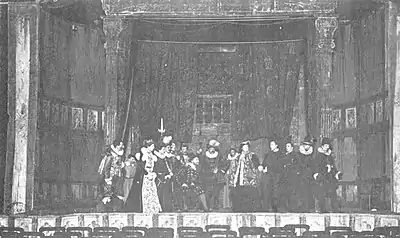William Poel
William Poel (1852-1934) was an English actor, theatrical manager and dramatist best known for his presentations of Shakespeare.

Life and career
A son of William Pole, he grew up among Pre-raphaelite painters and reportedly sat for William Holman Hunt in his painting The Finding of the Saviour in the Temple. He took on the name Poel following a misspelling of his own name on a theatre billing. At St. George's Hall, London, in 1881 he revived Hamlet, using the text of the first quarto and doing without scenery. From 1881 to 1883 he was manager of Royal Victoria Hall, London, and then for a year manager of F. R. Benson's company.
In 1895 he founded the Elizabethan Stage Society and spent much of his career researching and lecturing on Elizabethan performance. He put his studies to work on stage, as he tried to recreate performances using an open stage, a unified acting ensemble, an uncut text, very little scenery and a swift pace of performance. His work affected many theatre practitioners, most of all Harley Granville Barker. His presentations included Shakespeare's Measure for Measure (1893) and Two Gentlemen of Verona (1910), plays by Marlowe and Ben Jonson, Milton's Samson Agonistes (1900) and Swinburne's Locrine (1900).
Poel also dramatized W. D. Howells's A Foregone Conclusion under the title Priest and Painter (produced 1884) and Baring-Gould's novel Mehala (produced 1886). He wrote several comediettas and a book, Shakespeare in the Theatre. The National Portrait Gallery contains a number of pictures by Henry Tonks of Poel in the role as Father Keegan in G. B. Shaw's play John Bull's Other Island. His great-nephew Rupert Pole (1919-2006) was married to Anaïs Nin.
References
- Claris Glick, "William Poel: His Theories and Influence," Shakespeare Quarterly 15.1 (Winter, 1964): 15-25.
- C. E. Montague, Dramatic Values (New York, 1911).
- Speaight, Robert, William Poel and the Elizabethan Revival (Cambridge, Mass: Harvard Univ Press, 1954).
- This article incorporates text from a publication now in the public domain: Gilman, D. C.; Peck, H. T.; Colby, F. M., eds. (1905). New International Encyclopedia (1st ed.). New York: Dodd, Mead. Missing or empty
|title=(help)
External links
- William Poel Papers at the Kenneth Spencer Research Library, University of Kansas
- William Poel Collection in V & A Theatre Performance Collection
- William Poel letters in Add MS 46473 and in the George Bernard Shaw Papers at the British Library
- Works by William Poel at Project Gutenberg
- Works by or about William Poel at Internet Archive